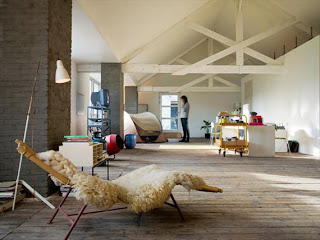(above left: Paolo Soleri's Arcology, right: Vincent Callebaut’s Lilypads)
Whether it’s through a classical,
modern or high-tech aesthetic, the style of utopian visions is almost always
that of overt rationalism on a grand scale. Visions such as Paolo Soleri’s
Acologies, Ron Herron’s Walking Cities and Vincent Callebaut’s Lilypads show
future worlds where humans have utilized technology to neatly control and
maintain the natural world around them.
These images distort the fact
that for a utopia to exist it is not the buildings which need to change, but
rather the people who live within them. Architecture is, of course, an
expression of the society in which it is built, and it is both influenced and
influential to that society, but are ostentatious, high-tech modern buildings
really the way forward?
In the countries which
repetitively score the highest in liveability, prosperity and happiness;
Denmark, Norway, Sweden, Iceland and Finland, instances of high-tech, or
overtly rational architecture are no more prevalent than anywhere else. Most of
the architecture in these countries is stylistically very similar to that of
the rest of the world. Internally the design aesthetics of these countries do
seem to have some unique characteristics in common; soft tones, minimal visual
mess and a subtle playfulness often expressed through handmade or vernacular
themed items. In these utopian Nordic countries a high-tech aesthetic is rarely
seen. As opposed to the overt rational grandness of most utopian visions the
architecture of these countries is typically simplistic in form and materiality
and subtle in detail.
For
utopia to manifest it would require people coming together and thoughtfully
resolving the issues they face, making do with what is available, rather than
having to create something completely new. Thoughtfulness and resourcefulness
are not ideas expressed by grandiose designs. These designs also fail another
important requirement for a successful society; the ability to integrate. For a
utopia to be real it would have to fit in with
the current context. In many cases dystopian visions, such as the artwork of
Daniel Dociu or the 2012 d3 Natural Systems Special Mention project ‘City
Rescuer: Detroit’, which display future communities co-existing in the detrital
architecture of today’s world, seem to show more promise of creating a better
real world than what is typically thought of as ‘Utopia’. Grand and grandiose designs, therefore, are a
fool’s utopia; a utopia which will not and cannot materialise.
In the words of Theo Crosby:
2012 d3 Natural Systems Special Mention project ‘City Rescuer: Detroit’)
In the words of Theo Crosby:
‘We reject these [modern] buildings only partly because they are crude and ugly. They are now seen to be philosophically and ideologically incorrect and are therefore obscene; obscene in precisely the same way as an over-decorated Victorian building appeared obscene to Adolf Loos... It is not that they are modern, or made of concrete... it is because they represent an intellectual attitude which we now reject.' Crosby, Pessimist Utopia, p8
(above left: Daniel Dociu - Rooftops, right:
2012 d3 Natural Systems Special Mention project ‘City Rescuer: Detroit’)
I finish with another quote from 'Pessimist Utopia'
‘In such a situation everyone is a pessimist. From this situation we have now to make us a utopia – in much the same way as Neolithic man set about cutting down the primal forests with little stone axes, so we have to make sense and romance out of decaying cities, shrinking economies, and unrealised aspirations. The pessimist begins with what is to hand, the ordinary wonderful world.’ p2





